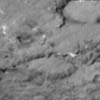| . |  |
. |
Santiago, Chile (SPX) Jul 15, 2005 Ten days after part of the Deep Impact spacecraft plunged onto Comet Tempel 1 with the aim to create a crater and expose pristine material from beneath the surface, astronomers are back in the ESO Offices in Santiago, after more than a week of observing at the ESO La Silla Paranal Observatory. In this unprecedented observing campaign � among the most ambitious ever conducted by a single observatory � the astronomers have collected a large amount of invaluable data on this comet. The astronomers have now started the lengthy process of data reduction and analysis. Being all together in a single place, and in close contacts with the space mission� scientific team, they will try to assemble a clear picture of the comet and of the impact. The ESO observations were part of a worldwide campaign to observe this unique experiment. During the campaign, ESO was connected by phone, email, and videoconference with colleagues in all major observatories worldwide, and data were freely exchanged between the different groups. This unique collaborative spirit provides astronomers with data taken almost around the clock during several days and this, with the largest variety of instruments, making the Deep Impact observing campaign one of the most successful of its kind, and thereby, ensuring the greatest scientific outcome. From the current analysis, it appears most likely that the impactor did not create a large new zone of activity and may have failed to liberate a large quantity of pristine material from beneath the surface. The images obtained at the VLT show that after the impact, the morphology of Comet Tempel 1 had changed, with the appearance of a new plume-like structure, produced by matter being ejected with a speed of about 700 to 1000 km/h (see ESO PR Photo 23/05). This structure, however, diffused away in the following days, being more and more diluted and less visible, the comet taking again the appearance it had before the impact. Further images obtained with, among others, the adaptive optics NACO instrument on the Very Large Telescope, showed the same jets that were visible prior to impact, demonstrating that the comet activity survived widely unaffected the spacecraft crash. The study of the gas in Comet Tempel 1, made with UVES on Kueyen (UT2 of the VLT), reveals a small flux increase the first night following the impact. At that time, more than 17 hours after the impact, the ejected matter was fading away but still measurable thanks to the large light collecting power of the VLT. The data accumulated during 10 nights around the impact have provided the astronomers with the best ever time series of optical spectra of a Jupiter Family comet, with a total of more than 40 hours of exposure time. This unique data set has already allowed the astronomers to characterize the normal gas activity of the comet and also to detect, to their own surprise, an active region. This active region is not related to the impact as it was also detected in data collected in June. It shows up about every 41 hours, the rotation period of the comet nucleus determined by the Deep Impact spacecraft. Exciting measurements of the detailed chemical composition (such as the isotopic ratios) of the material released by the impact as well as the one coming from that source will be performed by the astronomers in the next weeks and months. Further spectropolarimetric observations with FORS1 have confirmed the surface of the comet to be rather evolved � as expected � but more importantly, that the dust is not coming from beneath the surface. These data constitute another unique high-quality data set on comets. Comet Tempel 1 may thus be back to sleep but work only starts for the astronomers. More Information On July 4, 2005, the NASA Deep Impact spacecraft launched a 360 kg impactor onto Comet 9P/Tempel 1. This experiment is seen by many as the first opportunity to study the crust and the interior of a comet, revealing new information on the early phases of the Solar System. ESO actively participated in pre- and post-impact observations. Apart from a long-term monitoring of the comet, for two days before and six days after, all major ESO telescopes - i.e. the four Unit Telescopes of the Very Large Telescope Array at Paranal, as well as the 3.6m, 3.5m NTT and the 2.2m ESO/MPG telescopes at La Silla � have been observing Comet 9P/Tempel 1, in a coordinated fashion and in very close collaboration with the space mission' scientific team. The simultaneous use of all ESO telescopes with all together 10 instruments has an enormous potential, since it allows for observation of the comet at different wavelengths in the visible and infrared by imaging, spectroscopy and polarimetry. Such multiplexing capabilities of the instrumentation do not exist at any other observatory in the world. Related Links Deep Impact at ESO SpaceDaily Search SpaceDaily Subscribe To SpaceDaily Express
 Pasadena CA (SPX) Jul 11, 2005
Pasadena CA (SPX) Jul 11, 2005Data from Deep Impact's instruments indicate an immense cloud of fine powdery material was released when the probe slammed into the nucleus of comet Tempel 1 at 6.3 miles per second. |
|
| The content herein, unless otherwise known to be public domain, are Copyright 1995-2006 - SpaceDaily.AFP and UPI Wire Stories are copyright Agence France-Presse and United Press International. ESA PortalReports are copyright European Space Agency. All NASA sourced material is public domain. Additionalcopyrights may apply in whole or part to other bona fide parties. Advertising does not imply endorsement,agreement or approval of any opinions, statements or information provided by SpaceDaily on any Web page published or hosted by SpaceDaily. Privacy Statement |